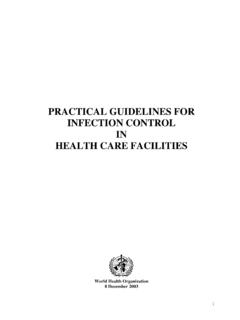Transcription of Central Venous Catheter Insertion and Maintenance
1 Central Venous Catheter Insertion and Maintenance A Tutorial on Recommended Practices Introduction Central Venous catheters (CVCs) are a commonly used modality throughout the medical center and especially in the intensive care units, serving a vital role in the management of critically ill patients. By definition, these devices involve placement of a large-bore Catheter into one of the body's main Central veins. Typical sites include the internal jugular, subclavian, and femoral veins. Although indications vary among critically ill patients, these catheters are usually placed for vasopressor and medication administration, large-volume infusions, phlebotomy, or hemodynamic monitoring. Various CVC devices are available, including introducers, multi-lumen catheters, PICC lines, and hemodialysis catheters.
2 Due to their size and location, CVCs confer a much greater risk for bloodstream infection (BSI) than simple peripheral intravenous lines. When a BSI. occurs in a critically ill patient, the additional costs and the risk of death can be extraordinary. Abbreviations BSI = bloodstream infection CDC = Centers for Disease Control and Prevention CVC = Central Venous Catheter ICU = intensive care unit NNIS = National Nosocomial Infection Surveillance system PICC = peripherally inserted Central Catheter HCW = healthcare worker 1. Introduction (continued). In most cases, episodes of Catheter -related bacteremia cannot be traced back to one specific cause. Rather, these infections are viewed as resulting from the cumulative exposure to a series of known potential risk factors.
3 These risk factors can be categorized according to the two phases of Catheter care: Insertion and daily management. This tutorial will discuss the most important of these risk factors, with a special emphasis on ways that providers can minimize the risks inherent in the Insertion phase. This website is intended for nurses and physicians working in our ICUs. Although individual facilities may differ, the topics outlined in this tutorial are universal and apply to most critical care settings. The guidelines in this tutorial are supported whenever possible by expert recommendations in the published literature. Of course, providers will ultimately need to make treatment decisions based on their own clinical judgment and individual patient characteristics.
4 Rationale The use of CVCs have increased considerably in the ICUs. Approximately 48% of all ICU patients have CVCs at some point during their hospital stay, accounting for over 15 million CVC-days per year in ICUs in the United States. However, CVCs, like any Venous Catheter , disrupt the integrity of the skin, leading to a portal for pathogen entry and subsequent CVC-related BSI. The burden of CVC-related BSIs in the United States is not small nor insignificant. Approximately 90% of Catheter -related BSIs occur with CVCs. The mortality attributable to CVC-related BSI is between 4% and 20%, and an estimated 500- 4000 patients die annually due to BSI. The attributable cost per infection is an estimated $34,508 $56,000, and the annual cost of caring for patients with CVC- related BSIs ranges from $296 million to $ billion.
5 2. Epidemiology A few organisms are responsible for most cases of CVC-related bacteremia. Most of these organisms reside on the skin surface. Coagulase- negative staphylococcus is the most commonly isolated bacterium; however, several other pathogens are common causes of CVC-related infections . Table 1 outlines the usual microbial causes of CVC-related BSI. Pathogen (%). Coagulase-negative staphylococci 37 %. Gram-negative rods 14 %. Enterobacter species 5%. Pseudomonas aeruginosa 4%. Klebsiella pneumoniae 3%. Escherichia coli 2%. Staphylococcus aureus 13 %. Enterococcus 13 %. Candida species 8%. Indications for CVC Placement CVC placement may be required for many reasons, including: 1. Rapid delivery of pharmcotherapeutic drugs or compounds 2.
6 Volume resuscitation 3. Hemodynamic instability/need for monitoring 4. Lack of sustainable peripheral access 5. Dialysis therapy 6. Long-term parenteral nutrition 7. Risk of intraoperative air embolism Placement of a Central Venous Catheter solely for ease of phlebotomy in a patient with adequate peripheral veins is strongly discouraged. 3. Teamwork & Quality Improvement Due to the substantial morbidity due to CVC-related BSI, efforts to reduce CVC-related BSI require coordination between all providers on a patient's care team. Accordingly, the physician must inform the patient's nurse at the earliest opportunity whenever CVC Insertion is anticipated ( not while draping the patient!). This important step allows the nursing staff to arrange proper coverage, thereby ensuring the nurse's availability during the entire procedure.
7 In general, a dedicated nurse should be at the bedside during every CVC Insertion . Physicians should defer elective line insertions until a nurse is available. By having a dedicated team of providers in the room, patient care is improved on several levels. First, the nurse functions as an assistant to the proceduralist who is otherwise unable to touch any object outside the sterile field. In addition, a team approach enhances patient safety. For example, if the nurse notices a break in sterile technique, the physician can be notified and the procedure stopped while the situation is remedied. Although some providers might feel uncomfortable making such suggestions, these types of behaviors improve patient safety and are essential for continuous quality improvement.
8 Obviously, a patient's safety is more important than a provider's autonomy. Teamwork & Quality Improvement (continued). Studies have shown that CVCs inserted by inexperienced providers have higher rates of infectious and mechanical complications. If a proceduralist has placed less than five (5) Central lines, a more experienced provider must properly supervise the procedure. The ICU leadership feels that protecting patient safety is the responsibility of all providers on a patient's team. Accordingly, the nursing staff is encouraged to ensure our inexperienced providers follow these standard guidelines 4. hand washing Good hand hygiene before Catheter Insertion or Maintenance is critical to reduce CVC-related infections .
9 Even if providers wear gloves, studies have consistently shown that hand washing immediately prior to the handling of a line reduces the incidence of infections . Use of a waterless, alcohol-based gel is at least as effective as traditional soap and water. All staff are expected to adhere to good hand hygiene practices both before and after contact with patients and their environment. Fingernails hand washing is an extremely effective way to prevent nosocomial infections , but fingernails often harbor microorganisms after thorough hand cleansing. Lengthy or artificial fingernails increase this tendency for pathogenic organisms to remain on the hands . For this reason, the Association of Operating Room Nurses has officially banned artificial nails in the operating room.
10 In general, health care providers should avoid wearing artificial nails at work and should keep their nails neatly trimmed. Catheter Insertion Site A Catheter in a peripheral vein has a much lower chance of infection than a Catheter in a Central vein. In fact, the majority of serious Catheter -related infections are associated with CVCs, not peripheral lines. A Catheter 's Insertion site directly influences the subsequent risk for Catheter -related infection. The density of skin flora at the Insertion site is a major risk factor for CVC-related BSI. Certain Insertion sites are easier to maintain in a clean and dry manner. Catheters inserted into an internal jugular vein are associated with higher risk for infection than those inserted into a subclavian vein.





